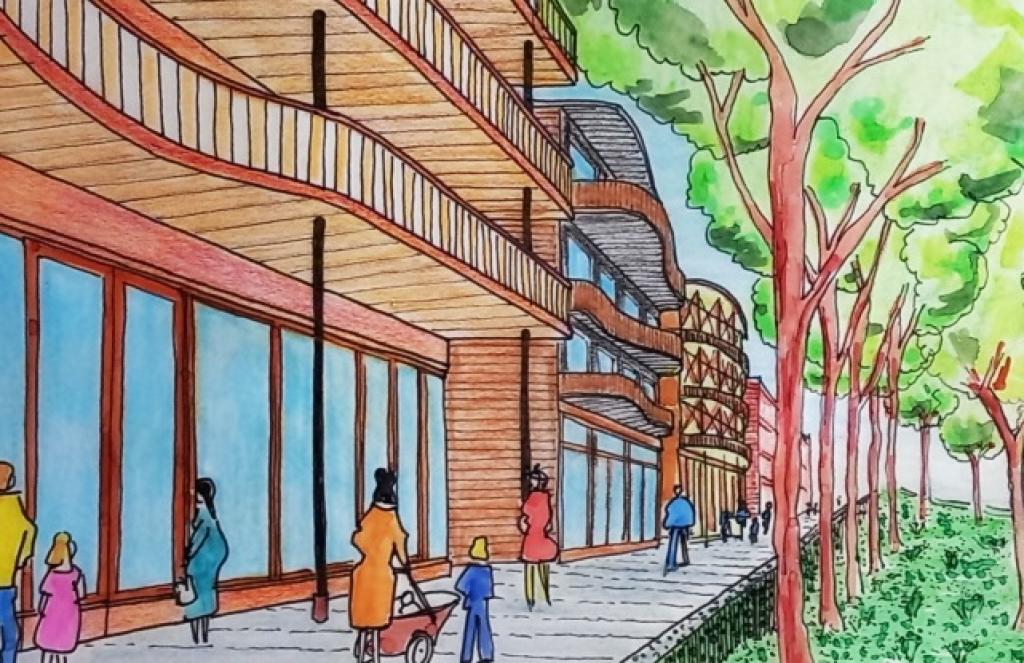Thessaloniki gets ready for its metro launch in November
The underground rapid transit lines have been under construction for almost two decades due to various project delays
 TheMayor.EU logo
TheMayor.EU logo 
The design of the future buildings will help them blend in naturally with the nearby park, Source: Municipality of Amsterdam
The buildings will be almost entirely constructed of this material and will blend in naturally with the nearby Nelson Mandela Park
Amsterdam is getting one step closer to building the first residential area in The Netherlands almost entirely made of wood. On the outskirts of Nelson Mandela Park and in the city’s Zuidoost (Southeast) neighbourhood, it is expected to become a sustainable neighbourhood with 725 homes and everything that its residents might need – school, shops, social and cultural facilities.
The stated horizon is 2026, but the city has already released the neighbourhood’s quality plan and is asking for feedback.
The visual quality plan of what is currently called Nelson Mandelabuurt (meaning Nelson Mandela neighbourhood, but this is only a working title) has been published by the city authorities of Amsterdam. The architectural guidelines and images for the buildings are available on this webpage and are expecting feedback between 6th July and 27 September 2023.
As indicated, contributions are welcome over email or post. All comments will receive a response, promise the authorities.
The future wooden residential area will comprise 9 residential blocks with different types of households: about 40 percent rental and 60 percent owner-occupied homes. Of the rental properties, 40 percent will be social housing, 40 percent middle segment and 20 percent free sector. There will also be self-build plots where future homeowners can construct their own homes.
The chosen architectural style has Caribbean influences, such as the Bruynzeel houses in Suriname. This suggests covered verandas and galleries and wooden stairs along the facades.
The plan says that the idea is to use wood on a large scale as a sustainable building material. Its proximity to the park is meant to match its natural look. The buildings will feature green roofs and rainwater storage systems. To a lesser extent, the project will use glass, concrete and steel.
Wood was selected not only because it blends in naturally with the nearby park. This “experimental building material” has many other advantages, the plan reads.
Among them is the fact that it is suitable for reuse. It is lightweight, easy to disassemble, easy to clean and transport and can be cut and reassembled without loss of quality.
Wood also has a positive effect on CO2 emissions, due to the CO2 storage capacity. Wood construction reduces nitrogen emissions and can therefore contribute to a solution for the current nitrogen crisis in the construction industry.
Furthermore, wood regulates heat and moisture in a natural way and its look and feel have a positive effect on the human psyche.

The underground rapid transit lines have been under construction for almost two decades due to various project delays

Now you can get your wine in Talence by paying directly in Bitcoin

That’s because the state has to spend money on updating the railway infrastructure rather than subsidizing the cost of the popular pass

Rethinking renewable energy sources for the urban landscape

The examples, compiled by Beyond Fossil Fuels, can inform and inspire communities and entrepreneurs that still feel trepidation at the prospect of energy transition

Now you can get your wine in Talence by paying directly in Bitcoin

The 10th European Conference on Sustainable Cities and Towns (ESCT) sets the stage for stronger cooperation between the EU, national and local level to fast track Europe's transition to climate neutrality.

At least, that’s the promise made by the mayor of Paris, Anne Hidalgo

The underground rapid transit lines have been under construction for almost two decades due to various project delays

At least, that’s the promise made by the mayor of Paris, Anne Hidalgo

Hostal de Pinós is located in the geographical centre of the autonomous region

Despite its church-y name, the district has long been known as the hangout spot for the artsy crowds

Urban dwellers across the EU are having a say in making their surroundings friendlier to people and the environment.

Forests in the EU can help green the European construction industry and bolster a continent-wide push for architectural improvements.

Apply by 10 November and do your part for the transformation of European public spaces

An interview with the Mayor of a Polish city that seeks to reinvent itself

An interview with the newly elected ICLEI President and Mayor of Malmö

A conversation with the Mayor of Lisbon about the spirit and dimensions of innovation present in the Portuguese capital














